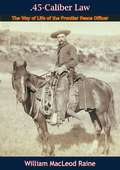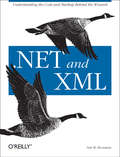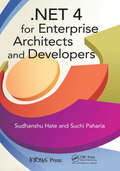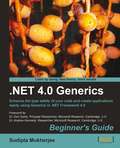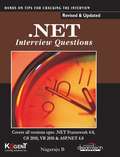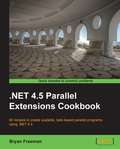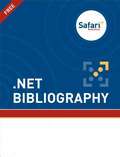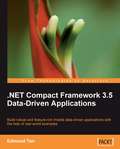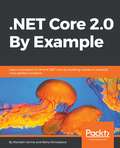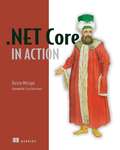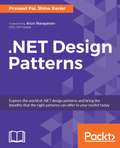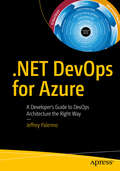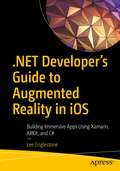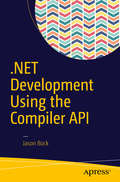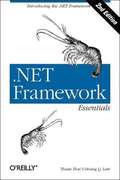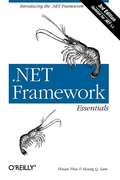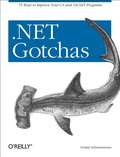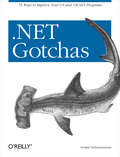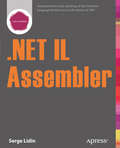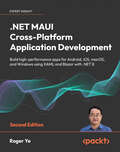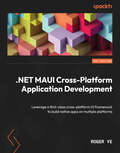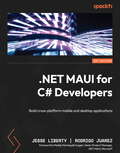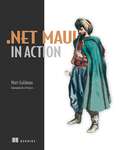- Table View
- List View
...y también poemas
by Roberto Gómez BolañosReconocido en todo el mundo de habla hispana como actor, guionista, comediante y creador de personajes inolvidables, Roberto Gómez Bolaños ha escrito teatro, television, cine... y también poemas. Con este libro, el autor descubre otra de sus facetas y nos ofrece poesía cálida, amorosa, a veces reflexiva, a veces humorística y siempre cercana, íntima, disfrutable. Escribe "a la antigua", en versos con rima, ritmo y métrica, con profundo respeto al quehacer poético, y en formas que se consideran clásicas: décima, romance y soneto.
.45-Caliber Law: The Way of Life of the Frontier Peace Officer
by William MacLeod RaineWilliam MacLeod Raine was a small boy when he came to this country in 1881 from London, England, with his father and brothers. They settled in the Southwest, then a land lawless at times and places. Jesse James and Billy the Kid still terrorized the districts in which they lived. Most of the characters mentioned in this book were alive, and vigorously fighting for or against the law, while Raine was growing up.After his graduation from Oberlin College, in Ohio, young Raine returned to the West and lived there, although with frequent excursions to other parts of the world. He had been a newspaper reporter, an editorial writer, a university lecturer, and a contributor to magazines.For more than sixty years Raine was in and of the West. He knew personally some of the men whose adventures he tells of in this book, and from other of their friends and acquaintances he picked up details and anecdotes. Even in his fiction Raine was noted for the accuracy with which he portrays the spirit and the background of the locale in which his characters move.
.NET & XML: Understanding the Code and Markup Behind the Wizards
by Niel M. BornsteinIf you're seeking ways to build network-based applications or XML-based web services, Microsoft provides most of the tools you'll need. XML is integrated into the .NET Framework and Visual Studio .NET, but if you want to get a grasp on how .NET and XML actually work together, that's a different story. With .NET & XML, you can get under the hood to see how the .NET Framework implements XML, giving you the skills to write understandable XML-based code that interoperates with code written with other tools, and even other languages..NET & XML starts by introducing XML and the .NET Framework, and then teaches you how to read and write XML before moving on to complex methods for manipulating, navigating, transforming, and constraining it. To demonstrate the power of XML in .NET, author Niel Bornstein builds a simple hardware store inventory system throughout the book. As you move from chapter to chapter, you'll absorb increasingly complex information until you have enough knowledge to successfully program your own XML-based applications. This tutorial also contains a quick reference to the API, plus appendices present additional .NET assemblies that you can use to work with XML, and how to work with the .NET XML configuration file format.One study puts the potential market for new software based on XML at or near $100 billion over the next five years. The .NET Framework gives you a way to become a part of it. But to use XML and .NET effectively, you need to understand how these two technologies work together. This book gives you the insight to take full advantage of the power the two provide.
.NET 4 for Enterprise Architects and Developers
by Sudhanshu Hate Suchi PahariaPresenting cutting-edge insights from industry practitioners, .NET 4 for Enterprise Architects and Developers supplies in-depth coverage of the various server-side features of Microsoft .NET Framework 4 that can be leveraged in Enterprise Application development. It provides a fundamental understanding of the technical aspects of implementation and
.NET 4.0 Generics Beginner’s Guide
by Sudipta MukherjeeThis is a concise, practical guide that will help you learn Generics in .NET, with lots of real world and fun-to-build examples and clear explanations. It is packed with screenshots to aid your understanding of the process. This book is aimed at beginners in Generics. It assumes some working knowledge of C# , but it isn't mandatory. The following would get the most use out of the book: Newbie C# developers struggling with Generics. Experienced C++ and Java Programmers who are migrating to C# and looking for an alternative to other generic frameworks like STL and JCF would find this book handy. Managers who want to know what Generics is and how to put it to good use. Architects will find the benchmarking extremely useful, because it's the first of its kind across a framework of several collections.
.NET 4.0 Interview Questions
by Nagaraju B.Highly recommended for beginners, students, and professionals, this book covers the unknown or hidden areas of NET implementation, starting from the basic to the advanced level-from NET Framework to OOPS to remoting to web services, i.e. VBNET, C#NET, and ASP NET; from ADO NET to XML, XSL, and XSLT; from Remoting, which forms the basis for advanced BizTalk, to SharePoint; from smart devices to Web Services and NET Framework 3.0 that discusses WPF, WF, WCF, and WCS foundations, and much more. Contents:- Framework ? Programming Concepts ? OOPS ? Windows Forms Controls ? ADO NET ? eXtensible Markup Language (XML) ? Remoting ? ASP NET NET Compact Framework ? Web Services NET Framework 3.0
.NET 4.5 Parallel Extensions Cookbook
by Bryan FreemanThis book contains practical recipes on everything you will need to create task-based parallel programs using C#, .NET 4.5, and Visual Studio. The book is packed with illustrated code examples to create scalable programs.This book is intended to help experienced C# developers write applications that leverage the power of modern multicore processors. It provides the necessary knowledge for an experienced C# developer to work with .NET parallelism APIs. Previous experience of writing multithreaded applications is not necessary.
.NET Bibliography
by Safari Content TeamWhen Microsoft released the first beta of the .NET Framework in 2000 it quickly became the default way of developing software for Windows. Rising from the technological legacy of COM, with the C# language, Common Language Runtime (CLR), Intermediate Language (IL) and Just-in-time (JIT) compilation, it was a modern platform that made it easy for Java and C++ developers to develop for Windows. At the same time, Visual Basic .NET provided a natural transition path for Visual Basic developers. Since then, .NET has evolved and branched through 7 major releases of the framework to the current day, and with Windows 8, Microsoft has surprised developers with a completely new UI stack. In this highly competitive world of technology, Microsoft makes the operating system that is running on over a billion computers, yet they continue innovating with unique features of programming languages, and breakthroughs such as Kinect or PixelSense. .NET offers an environment that is a pleasure to develop on and a consistent platform where you will feel at home moving from one technology stack to another. Should you decide to explore the exciting world of .NET development, be sure to use this bibliography to access Safari Books Online resources that will help you understand and master .NET programming.
.NET Compact Framework 3.5 Data Driven Applications
by Edmund TanThe book walks you through three different real-world mobile applications from head to toe to provide a practical, hands-on experience on how to use .NET CF. It provides you with code snippets (in both VB.NET and C#) from real-world business scenarios. A summary at the end of each chapter explains how these code snippets work together as a part of the larger whole. It also makes use of diagrams to explain core concepts and helps you decide on which design patterns to use in different enterprise application scenarios. This book is written for developers who are acquainted with the basics of .NET Compact Framework and want to create enterprise-level mobile applications. It is for developers who have worked with the .NET CF Framework before but would like to learn how to utilize its advanced features and deploy leaner and faster business applications.
.NET Core 2.0 By Example: Learn to program in C# and .NET Core by building a series of practical, cross-platform projects
by Rishabh Verma Neha ShrivastavaBuild cross-platform solutions with .NET Core 2.0 through real-life scenariosKey Features Bridges the gap between learning and doing and improves your software development skills Covers the best practices of .NET development to improve your productivity Example-based approach to get you started quickly with software programmingBook DescriptionWith the rise in the number of tools and technologies available today, developers and architects are always exploring ways to create better and smarter solutions. Before, the differences between target platforms was a major roadblock, but that's not the case now. .NET Core 2.0 By Example will take you on an exciting journey to building better software.This book provides fresh and relevant content to .NET Core 2.0 in a succinct format that’s enjoyable to read. It also delivers concepts, along with the implications, design decisions, and potential pitfalls you might face when targeting Linux and Windows systems, in a logical and simple way.With the .NET framework at its center, the book comprises of five varied projects: a multiplayer Tic-tac-toe game; a real-time chat application, Let'sChat; a chatbot; a microservice-based buying-selling application; and a movie booking application. You will start each chapter with a high-level overview of the content, followed by the above example applications described in detail. By the end of each chapter, you will not only be proficient with the concepts, but you’ll also have created a tangible component in the application.By the end of the book, you will have built five solid projects using all the tools and support provided by the .NET Core 2.0 framework.What you will learn Build cross-platform applications with ASP.NET Core 2.0 and its tools Integrate, host, and deploy web apps with the cloud (Microsoft Azure) Leverage the ncurses native library to extend console capabilities in .NET Core on Linux and interop with native coden .NET Core on Linux and learn how to interop with existing native code Reuse existing .NET Framework and Mono assemblies from .NET Core 2.0 applications Develop real-time web applications using ASP.NET Core Learn the differences between SOA and microservices and get started with microservice development using ASP.NET Core 2.0 Walk through functional programming with F# and .NET Core from scratchWho this book is forIf you are a developer or architect and want to learn how to build cross-platform solutions using Microsoft .NET Core, this book is for you. It is assumed that you have some knowledge of the .NET Framework, OOP, and C# (or a similar programming language).
.NET Core in Action
by Dustin MetzgarSummary .NET Core in Action shows .NET developers how to build professional software applications with .NET Core. Learn how to convert existing .NET code to work on multiple platforms or how to start new projects with knowledge of the tools and capabilities of .NET Core. Purchase of the print book includes a free eBook in PDF, Kindle, and ePub formats from Manning Publications. About the Technology .NET Core is an open source framework that lets you write and run .NET applications on Linux and Mac, without giving up on Windows. Built for everything from lightweight web apps to industrial-strength distributed systems, it's perfect for deploying .NET servers to any cloud platform, including AWS and GCP. About the Book .NET Core in Action introduces you to cross-platform development with .NET Core. This hands-on guide concentrates on new Core features as you walk through familiar tasks like testing, logging, data access, and networking. As you go, you'll explore modern architectures like microservices and cloud data storage, along with practical matters like performance profi ling, localization, and signing assemblies. What's Inside Choosing the right tools Testing, profiling, and debugging Interacting with web services Converting existing projects to .NET Core Creating and using NuGet packages About the Reader All examples are in C#. About the Author Dustin Metzgar is a seasoned developer and architect involved in numerous .NET Core projects. Dustin works for Microsoft. Table of Contents Why .NET Core? Building your first .NET Core applications How to build with .NET Core Unit testing with xUnit Working with relational databases Simplify data access with object-relational mappers Creating a microservice Debugging Performance and profiling Building world-ready applications Multiple frameworks and runtimes Preparing for release appendix A - Frameworks and runtimes appendix B - xUnit command-line options appendix C - What's in the .NET Standard Library? appendix D - NuGet cache locations
.NET Design Patterns
by Praseed Pai Shine XavierA practical and fast-paced guide that explores .NET design patternsAbout This BookThis book is based on the latest version of .NET, .NET Core 1.0.The code is explained piece by piece and the application of the pattern is also showcased.This fast-paced guide shows you how to implement the patterns into your existing applicationsWho This Book Is ForThis book is for those with familiarity with .NET development who would like to take their skills to the next level and be in the driver's seat when it comes to modern development techniques. Basic object-oriented C# programming experience and an elementary familiarity with the .NET framework library is required.What You Will LearnPut patterns and pattern catalogs into the right perspectiveApply patterns for software development under C#/.NETGOF and other patterns in real-life development scenariosHandle concurrency and parallelism using idioms under .NETLeverage Object/Functional programming by mixing OOP and FPUnderstand the Reactive Programming model using Rx and RxJsGet real-life insightsIn DetailKnowing about design patterns enables developers to improve their code base, promoting core reuse and making their architecture more robust.This book focuses on the practical aspects of coding in .NET. You will learn about all of the major design patterns, which will improve their functionality. We start with classic object-oriented programming (OOP) techniques, enhance implementations by mixing OOP and Functional Programming, and finally to the Reactive Programming model where Functional Programming and OOP are used in synergy to write better code.We'll focus on how to apply GOF patterns to solve real-life problems and improve the functionality of the software without changing the UI.Towards the end of this book, we'll show you how to deal with Architecture/Design techniques, GOF patterns, some patterns from other Catalogs, Functional Programming, and Reactive Programming techniques.After reading this book, you will be able to implement important design patterns for your programs, create major patterns viz. factory pattern, builder pattern, prototype patterns, adapter pattern, facade pattern, decorator pattern, etc.
.NET DevOps for Azure: A Developer's Guide to DevOps Architecture the Right Way
by Jeffrey PalermoUse this book as your one-stop shop for architecting a world-class DevOps environment with Microsoft technologies..NET DevOps for Azure is a synthesis of practices, tools, and process that, together, can equip a software organization to move fast and deliver the highest quality software. The book begins by discussing the most common challenges faced by developers in DevOps today and offers options and proven solutions on how to implement DevOps for your team.Daily, millions of developers use .NET to build and operate mission-critical software systems for organizations around the world. While the marketplace has scores of information about the technology, it is completely up to you to put together all the blocks in the right way for your environment.This book provides you with a model to build on. The relevant principles are covered first along with how to implement that part of the environment. And while variances in tools, language, or requirements will change the needed implementation, the DevOps model is the architecture for the working environment for your team. You can modify parts of the model to customize it to your enterprise, but the architecture will enable all of your teams and applications to accelerate in performance.What You Will LearnGet your .NET applications into a DevOps environment in AzureAnalyze and address the part of your DevOps process that causes delays or bottlenecksTrack code using Azure Repos and conduct acceptance testsApply the rules for segmenting applications into Git repositoriesUnderstand the different types of builds and when to use eachKnow how to think about code validation in your DevOps environmentProvision and configure environments; deploy release candidates across the environments in AzureMonitor and support software that has been deployed to a production environmentWho This Book Is For.NET Developers who are using or want to use DevOps in Azure but don’t know where to begin
.NET Developer's Guide to Augmented Reality in iOS: Building Immersive Apps Using Xamarin, ARKit, and C#
by Lee EnglestoneAttention .NET developers, here is your starting point for learning how to create and publish augmented reality (AR) apps for iOS devices. This book introduces and explores iOS augmented reality mobile app development specifically for .NET developers. The continued adoption and popularity of Xamarin, a tool that allows cross-platform mobile application development, opens up many app publishing opportunities to .NET developers that were never before possible, including AR development. You will use Xamarin to target Apple’s augmented reality framework, ARKit, to develop augmented reality apps in the language you prefer—C#. Begin your journey with a foundational introduction to augmented reality, ARKit, Xamarin, and .NET. You will learn how this remarkable collaboration of technologies can produce fantastic experiences, many of them never before tried by .NET developers. From there you will dive into the fundamentals and then explore various topics and AR features. Throughout your learning, proof of concepts will be demonstrated to reinforce learning. After reading this book you will have the fundamentals you need, as well as an understanding of the overarching concepts that combine them. You will come away with an understanding of the wide range of augmented reality features available for developers, including the newest features included in the latest versions of ARKit. What You Will Learn Create rich commercial and personal augmented reality mobile appsExplore the latest capabilities of ARKitExtend and customize chapter examples for building your own amazing appsGraduate from traditional 2D UI app interfaces to immersive 3D AR interfacesWho This Book Is For Developers who want to learn how to use .NET and C# to create augmented reality apps for iOS devices. It is recommended that developers have some Xamarin experience and are aware of the cross-platform options available to .NET. A paid Apple developer account is not needed to experiment with the AR code samples on your devices.
.NET Development Using the Compiler API
by Jason BockThis is the first book to describe the recent significant changes to the .NET compilation process and demonstrate how .NET developers can use the new Compiler API to create compelling applications. As an open source compiler, the Compiler API now makes its code available for anyone to use. In this book, you’ll get a concise, focused view of this tremendous resource for developers, who can now use any part of the platform implementation to their advantage in analyzing applications, improving code generation, and providing enforceable patterns, all under an OSS model.You will learn how to analyze your code for defects in a fast, clean manner never available before. You’ll work with solutions and projects to provide automatic refactoring, and you’ll discover how you can generate code dynamically to provide application implementations at runtimeHaving the Compiler API available opens a number of doors for .NET developers that were either simply not there before, or difficult to achieve. However, the API is vast, and this concise book provides a valuable roadmap to this new development environment.What You Will Learn:Understand how to generate, compile, and execute code for a number of scenariosHow to create diagnostics and refactoring to help developers enforce conventions and design idiomsExperiment with the compiler code base and see what can be done to influence the inner workings of the compilation pipelineWho This Book Is For:Experienced .NET developers, but detailed compiler knowledge is not necessary.
.NET Framework Essentials, 2nd Edition
by Hoang Lam Thuan L. Thai.NET Framework Essentials, 2nd Edition is a concise and technical overview of the Microsoft .NET Framework. Covered here are all of the most important topics--from the underlying Common Language Runtime (CLR) to its specialized packages for ASP.NET, Web Forms, Windows Forms, XML and data access (ADO.NET). The authors survey each of the major .NET languages, including Visual Basic .NET, C# and Managed C++.
.NET Framework Essentials, 2nd Edition
by Hoang Lam Thuan L. ThaiFully updated for Microsoft's official release, .NET Framework Essentials, 2nd Edition is an objective, concise, and technical overview of the new Microsoft .NET Framework for developing web applications and services. Specifically written for intermediate to advanced VB, C/C++, Java, and Delphi developers, .NET Framework Essentials, 2nd Edition is also useful to system architects and leaders who are assessing tools for future projects. The authors devote special attention to the writing of .NET components plus web applications and services. This book takes on all of the most important .NET Framework topics--from the underlying Common Language Runtime (CLR) to its specialized packages for ASP.NET, Web Forms, Windows Forms, XML and data access (ADO.NET). The authors survey each of the major .NET languages, including Visual Basic .NET, C#, and Managed C++, as well as MSIL, the intermediate language understood by the CLR. They've included working code samples in every .NET language. Compact and free of fluff or proprietary hype, .NET Framework Essentials, 2nd Edition is an outstanding value for experienced programmers and architects who need to get up to speed quickly.
.NET Framework Essentials, 3rd Edition
by Hoang Lam Thuan L. ThaiFully updated for version 1.1 of the .NET Framework, .NET Framework Essentials , 3rd Edition is an objective, concise, no-nonsense overview of the Microsoft .NET Framework for developing web applications and services. Written for intermediate to advanced VB, C/C++, Java, and Delphi developers, .NET Framework Essentials , 3rd Edition is also useful to system architects and leaders who are assessing tools for future projects. .NET Framework Essentials touches all the bases--from the Common Language Run-Time (CLR) and key class libraries to the specialized packages for ASP.NET, Windows Forms, XML Web Services, and data access (ADO.NET). The authors survey each major .NET language, including VB.NET, C#, J#, and Managed C++, as well as MSIL, clearing away the noise and hype, and presenting a clear, practical look at the underlying technologies. .NET Framework Essentials also provides a handy reference to the most commonly used features of .NET Framework. Written by two veteran web applications developers, .NET Framework Essentials , 3rd Edition is one of the most complete, concise, and ultimately useful books to describe the breadth of technology represented by .NET. Compact and free of fluff or proprietary hype, .NET Framework Essentials is an outstanding value for experienced programmers and architects who need to get up to speed quickly.
.NET Gotchas
by Venkat SubramaniamLike most complex tasks, .NET programming is fraught with potential costly, and time-consuming hazards. The millions of Microsoft developers worldwide who create applications for the .NET platform can attest to that. Thankfully there's now a book that shows you how to avoid such costly and time-consuming mistakes. It's called .NET Gotchas . The ultimate guide for efficient, pain-free coding, .NET Gotchas from O'Reilly contains 75 common .NET programming pitfalls--and advice on how to work around them. It will help you steer away from those mistakes that cause application performance problems, or so taint code that it just doesn't work right. The book is organized into nine chapters, each focusing on those features and constructs of the .NET platform that consistently baffle developers. Within each chapter are several "gotchas," with detailed examples, discussions, and guidelines for avoiding them. No doubt about it, when applied, these concise presentations of best practices will help you lead a more productive, stress-free existence. What's more, because code examples are written in both VB.NET and C#, .NET Gotchas is of interest to more than 75 percent of the growing numbers of .NET programmers. So if you're a .NET developer who's mired in the trenches and yearning for a better way, this book is most definitely for you.
.NET Gotchas: 75 Ways to Improve Your C# and VB.NET Programs
by Venkat SubramaniamLike most complex tasks, .NET programming is fraught with potential costly, and time-consuming hazards. The millions of Microsoft developers worldwide who create applications for the .NET platform can attest to that. Thankfully there's now a book that shows you how to avoid such costly and time-consuming mistakes. It's called .NET Gotchas.The ultimate guide for efficient, pain-free coding, .NET Gotchas from O'Reilly contains 75 common .NET programming pitfalls--and advice on how to work around them. It will help you steer away from those mistakes that cause application performance problems, or so taint code that it just doesn't work right.The book is organized into nine chapters, each focusing on those features and constructs of the .NET platform that consistently baffle developers. Within each chapter are several "gotchas," with detailed examples, discussions, and guidelines for avoiding them. No doubt about it, when applied, these concise presentations of best practices will help you lead a more productive, stress-free existence.What's more, because code examples are written in both VB.NET and C#, .NET Gotchas is of interest to more than 75 percent of the growing numbers of .NET programmers. So if you're a .NET developer who's mired in the trenches and yearning for a better way, this book is most definitely for you.
.NET IL Assembler
by Serge LidinAdvanced .NET IL Assembler is a comprehensive drill-down into the inner workings of the .NET Framework. Acknowledged runtime expert and Microsoft insider Serge Lidin steps through the internal structures and operations that take place when .NET code is executed, showing how the syntax and grammar of the coding language is broken down into low-level units that can be expressed through the ILAsm language that runs behind the scenes in .NET. By reading this book you will develop the skills you need to write tighter, faster, .NET code; to debug complex error handling situations; and to oversee multi-language and multi-platform projects with confidence.
.NET MAUI Cross-Platform Application Development: Build high-performance apps for Android, iOS, macOS, and Windows using XAML and Blazor with .NET 8
by Roger YeBuild apps using .NET MAUI and Blazor with this comprehensive, revised guide for .NET 8. Purchase of the print or Kindle book includes a free eBook in PDF format.Key FeaturesHandle data effectively with expanded coverage on the MVVM model and data bindingIntegrate platform-specific code using plugins and custom controlsMigrate from Xamarin.Forms to .NET MAUI for the latest hybrid app development capabilitiesBook DescriptionAn evolution of Xamarin.Forms, .NET MAUI is a cross-platform framework for creating native mobile and desktop apps with C# and XAML. Using .NET MAUI, you can develop apps that’ll run on Android, iOS, macOS, and Windows from a single shared codebase. In this revised edition of .NET MAUI Cross-Platform Application Development you will be introduced to .NET 8 and get up to speed with app development in no time. The book begins by showing you how to develop a cross-platform application using .NET MAUI, including guidance for migrating from Xamarin.Forms. You’ll gain all the knowledge needed to create a cross-platform application for Android, iOS, macOS, and Windows following an example project step by step. As you advance, you’ll integrate the latest frontend technology into your app using Blazor components, including the new Blazor Bindings feature. After this, you’ll learn how to test and deploy your apps. With new coverage on creating mock .NET MAUI components, you can develop unit tests for your application. You will additionally learn how to perform Razor component testing using bUnit. By the end of this book, you’ll have learned how to develop your own cross-platform applications using .NET MAUI.What you will learnDevelop high-performance apps with logical user interfacesImprove the maintainability of apps using the MVVM design patternUnderstand the progression from Xamarin.Forms and how to migrate to .NETDelve into templated components and Razor class libraries for crafting Blazor UI elementsPublish your creations to major app stores with guidance on preparation and processesExtend your testing repertoire with bUnit for Razor components for reliable unit testingWho this book is forThis book is for mobile developers interested in cross-platform application development with working experience of the .NET Core framework, as well as junior engineers who’ve just begun their career in mobile app development. Native app developers (desktop) or Xamarin developers who want to migrate to .NET MAUI will also benefit from this book. Basic knowledge of modern object-oriented programming languages, such as C#, Java or Kotlin, is assumed.
.NET MAUI Cross-Platform Application Development: Leverage a first-class cross-platform UI framework to build native apps on multiple platforms
by Roger YeBuild apps for Android, iOS, macOS, and Windows using Microsoft's .NET Multi-platform App UI and BlazorKey FeaturesGet familiar with Microsoft's UI toolkit to build amazing interfaces for iOS, Android, Windows, and macOSBuild a cross-platform password manager based on the famous Windows app, KeePassExplore .NET MAUI development and Hybrid app development using BlazorBook DescriptionAn evolution of Xamarin.Forms, .NET Multi-platform App UI (.NET MAUI) is a cross-platform framework for creating native mobile and desktop apps with C# and XAML. Using .NET MAUI, you can develop apps that'll run on Android, iOS, macOS, and Windows from a single shared code-base. This step-by-step guide provides a comprehensive introduction to those who are new to .NET MAUI that will have you up to speed with app development using .NET MAUI in no time.The book begins by showing you how to develop a cross-platform application using .NET MAUI and then helps you build an app throughout the chapters. You'll gain all the knowledge needed to create a cross-platform application for Android, iOS, the mac OS, and Windows from a single shared code-base using .NET MAUI. As you advance, you'll get to grips with the entire application development lifecycle, from design and implementation through to deployment to the app store through the development of a password manager app using KeePassLib. The concluding chapters will teach you how to integrate the latest frontend technology into your app through .NET MAUI Blazor.By the end of this book, you'll have learned how to develop your own cross-platform applications using .NET MAUI.What you will learnDiscover the latest features of .NET 6 that can be used in mobile and desktop app developmentFind out how to build cross-platform apps with .NET MAUI and BlazorImplement device-specific features using .NET MAUI EssentialsIntegrate third-party libraries and add your own device-specific featuresDiscover .NET class unit test using xUnit.net and Razor components unit test using bUnitDeploy apps in different app stores on mobile as well as desktopWho this book is forThis book is an entry-level .NET MAUI book for mobile developers interested in cross-platform application development with working experience of the .NET Core framework, as well as fresh or junior engineers who've just begun their career in mobile app development. Native application developers (desktop) or Xamarin developers who want to migrate to .NET MAUI will also benefit from this book. Basic knowledge of modern object-oriented programming language, such as C#, Java or Kotlin, is assumed.
.NET MAUI for C# Developers: Build cross-platform mobile and desktop applications
by Jesse Liberty Rodrigo Juarez Maddy Montaquila (Leger)A practical guide to mastering C# and .NET MAUI to build native cross-platform apps with a single codebasePurchase of the print or Kindle book includes a free PDF eBookKey FeaturesExtend your skills to build cross-platform native apps for iOS, Android, Windows, and MacLearn by working on a real-world projectGo beyond MAUI and integrate with the .NET ecosystemBook DescriptionWhile UI plays a pivotal role in retaining users in a highly competitive landscape, maintaining the same UI can be tricky if you use different languages for different platforms, leading to mismatches and un-synced pages. In this book, you'll see how .NET MAUI allows you to create a real-world application that will run natively on different platforms. By building on your C# experience, you'll further learn to create beautiful and engaging UI using XAML, architect a solid app, and discover best practices for this Microsoft platform. The book starts with the fundamentals and quickly moves on to intermediate and advanced topics on laying out your pages, navigating between them, and adding controls to gather and display data. You'll explore the key architectural pattern of Model-View-ViewModel: and ways to leverage it. You'll also use xUnit and NSubstitute to create robust and reliable code.By the end of this book, you'll be well-equipped to leverage .NET MAUI and create an API for your app to interact with a web frontend to the backend data using C#.What you will learnExplore the fundamentals of creating .NET MAUI apps with Visual StudioUnderstand XAML as the key tool for building your user interfaceObtain and display data using layout and controlsDiscover the MVVM pattern to create robust appsAcquire the skills for storing and retrieving persistent dataUse unit testing to ensure your app is solid and reliableWho this book is forLearning .NET MAUI is targeted squarely at C# programmers, whether or not they have experience with cross-platform or mobile applications, who wish to learn Microsoft's premier platform for building iOS, Android, Windows and Mac apps using a single C#-based solution.
.NET MAUI in Action (In Action)
by Matt GoldmanBuild cross-platform apps with .NET MAUI! This exciting new technology helps you create mobile and desktop apps using a common set of .NET tools.In .NET MAUI in Action you will learn how to: Set up your environment for cross-platform development Write an interactive UI in XAML using out-of-the-box controls Apply the MVVM pattern to build maintainable code Extend your control library with custom controls Structure your app using common navigation paradigms Use common device features like GPS Use DevOps tools to automate deployment and testing .NET MAUI in Action shows you how you can use the cutting-edge MAUI framework to write apps that will run on Windows, Android, macOS, and iOS platforms using your existing .NET development skills. This book reveals essential MAUI development techniques through hands-on example applications in every chapter. You&’ll learn cross-platform development quickly as you start building your own rich apps, from to-do list apps, to a movie recommender app, and eventually a full-stack solution using enterprise architecture patterns. You&’ll also learn how to use GitHub Actions to deploy robust, testable, and maintainable apps; and how to deliver a consistent look and feel across platforms. Throughout, you&’ll use the built-in controls of .NET MAUI and learn how to develop your own custom solutions. Foreword by Kym Phillpotts. About the technology Write your app once and deploy it on mobile, desktop, web, and cloud with .NET MAUI. This powerful multi-platform App UI framework saves time and money by eliminating tedious platform-specific rewrites. You just define your project in straightforward XAML markup and C#, and MAUI generates the native applications for iOS, Android, Windows, and macOS. About the book .NET MAUI in Action teaches you how to build cross-platform applications using the .NET MAUI framework. You&’ll explore compelling examples while you work your way up from &“Aloha World&” to a full-stack enterprise solution. Along the way, you&’ll master the MVVM pattern and other essentials of mobile UI development. This practical book is perfect for .NET developers who have never created mobile apps. What's inside Write interactive UIs in XAML using out-of-the-box controls Extend your control library with custom controls Use common device features like GPS Automate deployment and testing About the reader For experienced .NET developers. No iOS or Android experience required. About the author Matt Goldman is a Solution Architect at SSW, a regular speaker at user groups and conferences, and maintains open source libraries for use in .NET MAUI apps. Table of Contents PART 1 - INTRODUCING .NET MAUI 1 Introducing .NET MAUI 2 Building a .NET MAUI app 3 Making .NET MAUI apps interactive PART 2 - VIEWS, LAYOUTS, AND CONTROLS 4 Controls 5 Layouts 6 Advanced layout concepts 7 Pages and navigation PART 3 - ENTERPRISE DEVELOPMENT PATTERNS AND PRACTICES 8 Enterprise app development 9 The MVVM Pattern 10 Styles, themes, and multiplatform layouts 11 Beyond the basics: Custom controls 12 Deploying apps to production with GitHub Actions

